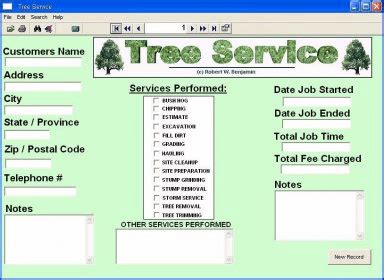Tree Service Software

In the bustling landscape of the tree care industry, efficiency and organization are paramount. Tree service software has emerged as a powerful tool, revolutionizing the way businesses manage their operations, from estimating costs to scheduling jobs and maintaining client relationships. This innovative technology has not only streamlined processes but has also elevated the overall professional image of tree service companies, setting new standards for success in this green-collar sector.
The Evolution of Tree Service Management

The journey of tree service businesses from traditional, paper-based systems to digital platforms has been transformative. Early adopters of tree service software quickly recognized its potential to enhance productivity and reduce operational costs. This shift marked a significant advancement, enabling companies to manage their operations more efficiently and effectively.
The core functionalities of tree service software revolve around streamlining the entire workflow, from the initial customer inquiry to the final job completion. This includes creating detailed estimates, managing customer relationships, scheduling jobs, and tracking equipment and employee performance. By digitizing these processes, tree service companies can reduce administrative burdens, minimize errors, and allocate more resources to core activities, ultimately improving their bottom line.
Key Features and Benefits of Tree Service Software
Tree service software offers a wide array of features designed to cater to the unique needs of the industry. One of the most valuable capabilities is the ability to generate precise estimates. These estimates can be tailored to each client’s needs, incorporating factors such as tree height, diameter, accessibility, and the complexity of the job. This level of detail not only ensures accuracy but also helps build trust and transparency with clients.
Another critical aspect is job management. Tree service software enables businesses to schedule jobs efficiently, ensuring that resources are allocated optimally. It also facilitates real-time communication with field teams, providing updates on job progress and any changes or challenges encountered. This real-time visibility enhances coordination and ensures jobs are completed promptly and to the highest standards.
Moreover, tree service software excels in customer relationship management (CRM). It allows businesses to maintain detailed records of client interactions, preferences, and job histories. This information can be leveraged to offer personalized services, targeted marketing, and timely reminders, fostering strong client relationships and increasing customer loyalty.
Additionally, tree service software provides robust reporting and analytics capabilities. Businesses can generate detailed reports on various aspects of their operations, such as job profitability, equipment utilization, and employee performance. These insights enable informed decision-making, strategic planning, and the identification of areas for improvement or expansion.
| Feature | Description |
|---|---|
| Estimate Generation | Software can create detailed estimates based on tree characteristics and job complexity. |
| Job Scheduling | Efficiently manage and allocate resources, with real-time updates for field teams. |
| Customer Relationship Management (CRM) | Maintain comprehensive client records for personalized services and targeted marketing. |
| Reporting & Analytics | Generate detailed reports for job profitability, equipment utilization, and performance analysis. |

Implementing Tree Service Software: A Strategic Approach

Implementing tree service software is a strategic decision that requires careful planning and consideration. It’s not just about choosing the right software but also ensuring that it aligns with the company’s goals, workflows, and existing systems. A well-planned implementation strategy can make the transition smooth and ensure maximum benefits from the software.
Choosing the Right Software
The first step is selecting a tree service software that best suits the specific needs of the business. This involves evaluating various software options, considering factors such as the size of the business, the complexity of operations, and the desired level of customization. It’s essential to choose a software that is scalable, user-friendly, and backed by reliable customer support.
Key considerations when choosing tree service software include:
- Functionality: Ensure the software covers all the essential aspects of tree service management, from estimating to job scheduling and CRM.
- User Experience: Opt for software with an intuitive interface to minimize training time and enhance user adoption.
- Scalability: Choose a software that can grow with the business, accommodating future expansion and changing needs.
- Integration: Select a software that integrates seamlessly with existing systems and tools, such as accounting software or field management apps.
Training and Adoption
Once the software is selected, a comprehensive training program should be implemented to ensure that all team members understand and embrace the new system. This training should cover not only the technical aspects of the software but also the ways in which it can enhance their daily workflows and overall efficiency.
Encouraging user adoption is critical to the success of tree service software implementation. Here are some strategies to promote adoption:
- Provide clear, concise documentation and training materials.
- Offer ongoing support and troubleshooting resources.
- Incorporate the software into daily workflows gradually, allowing users to become comfortable with its features.
- Highlight the benefits of the software, such as improved accuracy, efficiency, and client satisfaction.
Customizing for Your Business
Every tree service business is unique, and the software should reflect these unique needs. Customization options allow businesses to tailor the software to their specific workflows, job types, and client requirements. This might include creating custom fields for estimates, defining specific job types, or setting up automated workflows for common tasks.
By customizing the software, businesses can ensure that it aligns perfectly with their operations, making it an indispensable tool for daily tasks. This level of customization not only enhances efficiency but also empowers businesses to provide even better service to their clients.
Case Studies: Real-World Success Stories
The impact of tree service software can be best understood through real-world success stories. Here are some case studies that highlight the tangible benefits of implementing such software.
Efficient Operations at GreenThumb Tree Service
GreenThumb Tree Service, a medium-sized business in the Pacific Northwest, implemented tree service software to streamline its operations. The software enabled them to reduce administrative burdens, with estimates being generated quickly and accurately. This not only saved time but also reduced errors, ensuring a more efficient process.
The software's job management capabilities allowed GreenThumb to optimize resource allocation, ensuring that jobs were completed promptly and efficiently. With real-time updates, the field teams could stay informed and adapt to changing circumstances, enhancing their productivity.
Furthermore, GreenThumb leveraged the software's CRM features to maintain detailed client records. This enabled them to offer personalized services and targeted marketing, resulting in increased customer loyalty and repeat business. By understanding their clients' needs and preferences, GreenThumb could provide tailored solutions, further enhancing their reputation and success.
Profitability Boost for ArborPro
ArborPro, a large tree service business with multiple locations, implemented tree service software to improve profitability. The software’s robust reporting and analytics capabilities allowed ArborPro to identify areas of inefficiency and make data-driven decisions to improve their operations.
By analyzing job profitability, ArborPro could adjust their pricing strategies and optimize job scheduling to maximize revenue. They could also identify high-performing employees and equipment, allowing for better resource allocation and improved efficiency. The software's insights into equipment utilization helped ArborPro make informed decisions about equipment purchases and maintenance, further contributing to their bottom line.
Enhanced Customer Service at Leafy Solutions
Leafy Solutions, a small tree service business, implemented tree service software to enhance their customer service. The software’s estimate generation capabilities allowed them to provide accurate, detailed estimates, building trust with their clients. By incorporating factors such as tree height and complexity, Leafy Solutions could offer precise pricing, ensuring client satisfaction.
The software's CRM features enabled Leafy Solutions to maintain a comprehensive record of client interactions and preferences. This allowed them to offer personalized services and timely reminders, fostering strong client relationships. By prioritizing customer satisfaction, Leafy Solutions saw an increase in word-of-mouth referrals and repeat business, solidifying their position in the local market.
The Future of Tree Service Software
As the tree service industry continues to evolve, so too will the role of software. The future of tree service software is poised to bring even greater efficiency, with advancements in artificial intelligence (AI) and machine learning (ML) playing a significant role.
AI and ML Integration
AI and ML technologies will increasingly be integrated into tree service software, enhancing its capabilities and improving overall efficiency. For instance, AI-powered image recognition could be used to analyze tree conditions, providing valuable insights for estimates and job planning. ML algorithms could also be employed to optimize job scheduling, taking into account factors such as traffic conditions and weather forecasts.
Additionally, AI-powered chatbots could enhance customer service, providing quick responses to common queries and freeing up human customer service representatives to handle more complex issues. These advancements will not only improve efficiency but also enhance the customer experience, setting new standards for excellence in the tree service industry.
Mobile and Field Service Optimization
Mobile technology will continue to play a pivotal role in the future of tree service software. Field service optimization, enabled by mobile apps and devices, will allow for real-time job tracking, updates, and communication. This will further enhance coordination between office and field teams, ensuring seamless operations and improved customer service.
Moreover, mobile apps can facilitate the collection of job data and client feedback in the field, providing valuable insights for continuous improvement. By leveraging mobile technology, tree service businesses can stay agile, responsive, and adaptable to changing market demands.
Industry-Specific Innovations
Tree service software will continue to innovate, introducing features tailored to the unique needs of the industry. This might include specialized tools for estimating the value of trees, calculating carbon sequestration, or tracking the health and growth of trees over time. These industry-specific innovations will not only enhance the accuracy and efficiency of tree service operations but also contribute to the broader goals of sustainability and environmental stewardship.
Conclusion: Embracing the Digital Transformation

Tree service software is a powerful tool that has revolutionized the way tree service businesses operate. By streamlining processes, enhancing customer service, and providing valuable insights, this software has become an indispensable asset for the industry.
As we look to the future, the continued evolution of tree service software promises even greater efficiency and innovation. With the integration of AI, ML, and mobile technologies, tree service businesses can expect to operate with even more agility, precision, and responsiveness. By embracing these digital transformations, the industry can continue to thrive, offering excellent service while contributing to the health and beauty of our natural environment.
How does tree service software enhance customer service?
+
Tree service software improves customer service by offering accurate estimates, detailed job management, and personalized interactions. It enables businesses to provide transparent pricing, efficient job scheduling, and timely reminders, fostering strong client relationships and increasing customer satisfaction.
What are the key benefits of implementing tree service software?
+
Implementing tree service software offers several benefits, including streamlined operations, reduced administrative burdens, improved job efficiency, and enhanced customer service. It also provides valuable insights through reporting and analytics, enabling data-driven decision-making and strategic planning.
How can I choose the right tree service software for my business?
+
When choosing tree service software, consider factors such as your business size, operational complexity, and customization needs. Opt for software that is scalable, user-friendly, and integrates well with your existing systems. Evaluate functionality, user experience, and support to ensure a good fit for your specific requirements.
What is the role of AI and ML in tree service software?
+
AI and ML technologies are integrated into tree service software to enhance capabilities and improve efficiency. AI-powered features can include image recognition for tree analysis, ML-optimized job scheduling, and AI chatbots for customer service. These innovations will continue to shape the future of the industry, bringing greater accuracy and responsiveness.



